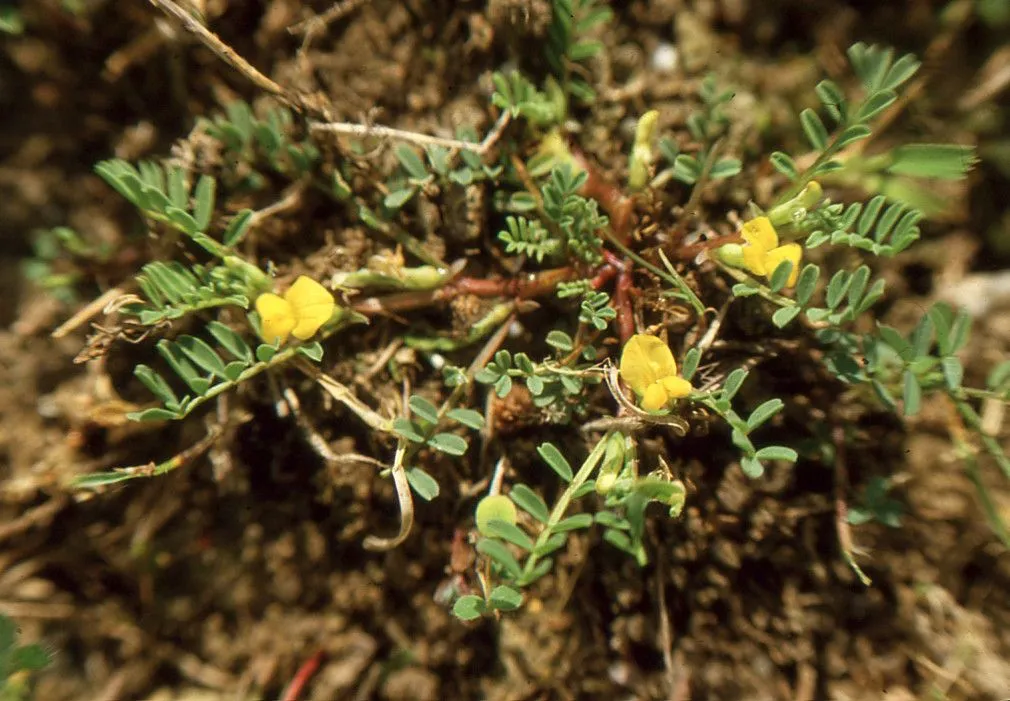
Author: L.
Bibliography: Sp. Pl.: 737 (1753)
Year: 1753
Status: accepted
Rank: species
Genus: Vicia
Vegetable: False
Observations: Medit. to C. Asia and Afghanistan
Hairy yellow vetch, known scientifically as Vicia hybrida, is a fascinating plant that adds value to both natural and agricultural landscapes. Described originally in the seminal work “Species Plantarum” in 1753 by the renowned botanist Carl Linnaeus, this species has since gained recognition for its unique characteristics and adaptability.
Part of the Fabaceae family, which is commonly referred to as the legume, pea, or bean family, Vicia hybrida is notable for its production of nitrogen, an essential nutrient for soil health. The plant’s presence is particularly beneficial in agricultural settings where crop rotation and soil enrichment are critical.
Geographically, the habitat of Vicia hybrida spans from the Mediterranean region to central Asia and Afghanistan. This wide range indicates the plant’s hardy nature and ability to thrive under diverse climatic conditions. Its adaptability makes it a resilient species able to grow in various environments, from temperate to more arid regions.
Characterized by its hairy stems and yellow flowers, the plant exhibits a unique aesthetic that sets it apart from other members of the Vicia genus. The hairs on the stems play a crucial role in protecting the plant from herbivores and reducing water loss, an adaptation that ensures its survival in less hospitable terrains.
In addition to its ecological benefits, Vicia hybrida possesses qualities that make it an interesting subject of study for botanists and ecologists alike. Its ability to fix atmospheric nitrogen through a symbiotic relationship with root bacteria not only aids its growth but also enhances the fertility of the soil in which it grows. This natural process reduces the need for chemical fertilizers, making hairy yellow vetch an excellent component of sustainable farming practices.
Whether observed in a wild meadow or integrated into a managed agricultural system, hairy yellow vetch serves as a testament to the intricate connections within ecosystems and the importance of biodiversity. Its enduring presence from the Mediterranean to the rugged landscapes of central Asia and Afghanistan underscores the plant’s ecological significance and versatility.
Eng: hairy yellow vetch, hairy yellow-vetch
Dan: svovl-vikke
Swe: solvicker
Nld: basterdwikke
En: Hairy yellow vetch, Hairy Yellow-vetch
Da: Svovl-vikke
Nl: Basterdwikke
Fr: Vesce bâtarde, Vesce hybride
De: Bastard-Wicke, Haarfahnen-Wicke
He: בקיית הכלאיים
It: Veccia pelona
Sv: Solvicker
Taken Mar 11, 2021 by tonysalix77 (cc-by-sa)
Taken Mar 7, 2022 by Hansjoerg Hageld (cc-by-sa)
Taken Mar 24, 2021 by Julián Díaz (cc-by-sa)
Taken May 26, 2019 by Peteh Natali (cc-by-sa)
Taken Apr 25, 2020 by Marco Pizziolo (cc-by-sa)
Taken Apr 18, 2014 by Tela Botanica − Liliane Roubaudi (cc-by-sa)
Taken Apr 25, 2015 by Tela Botanica − Ans GORTER (cc-by-sa)
Taken Apr 7, 2019 by Michel Bataille (cc-by-sa)
Taken Mar 19, 2022 by Valérie Duflot (cc-by-sa)
Taken Mar 24, 2021 by Julián Díaz (cc-by-sa)
Taken May 8, 2018 by Tela Botanica − Sylvain PIRY (cc-by-sa)
Taken Apr 6, 2019 by bas yves (cc-by-sa)
Taken Feb 5, 2016 by EOL − Drepanostoma (cc-by-nc)
Taken May 18, 2021 by Llandrich anna (cc-by-sa)
Taken Apr 7, 2021 by françois boca (cc-by-sa)
Taken May 18, 2021 by Llandrich anna (cc-by-sa)
Taken Apr 21, 2020 by Flore Crombé (cc-by-sa)
Taken May 30, 2021 by Alexandre Lg (cc-by-sa)
Taken Mar 16, 2017 by Tela Botanica − Liliane ROUBAUDI (cc-by-sa)
Taken Apr 25, 2015 by Tela Botanica − Ans GORTER (cc-by-sa)
Taken May 7, 2013 by Tela Botanica − Marie PORTAS (cc-by-sa)
Taken Jun 6, 2013 by Tela Botanica − Ans GORTER (cc-by-sa)
Taken Jun 6, 2013 by Tela Botanica − Ans GORTER (cc-by-sa)
Taken May 28, 2013 by Tela Botanica − Françoise CARLE (cc-by-sa)
Taken May 27, 2014 by Tela Botanica − Jean-Jacques HOUDRÉ (cc-by-sa)
Taken Apr 16, 2017 by Tela Botanica − Thibaud CORRENOZ (cc-by-sa)
Taken Apr 26, 1986 by Tela Botanica − Liliane ROUBAUDI (cc-by-sa)
Taken Mar 9, 2022 by Théo Detambel (cc-by-sa)
Taken Apr 26, 1986 by Tela Botanica − Liliane ROUBAUDI (cc-by-sa)
Taken Mar 29, 2006 by Andrew Gagg (cc-by-sa)
© copyright of the Board of Trustees of the Royal Botanic Gardens, Kew.
© copyright of the Board of Trustees of the Royal Botanic Gardens, Kew.
© copyright of the Board of Trustees of the Royal Botanic Gardens, Kew.
Growth habit: Forb/herb, Vine
Bloom months: [‘apr’, ‘may’, ‘jun’]
Family: Myrtaceae Author: (F.Muell.) K.D.Hill & L.A.S.Johnson Bibliography: Telopea 6: 402 (1995) Year: 1995 Status:…
Family: Rubiaceae Author: Pierre ex A.Froehner Bibliography: Notizbl. Bot. Gart. Berlin-Dahlem 1: 237 (1897) Year:…
Family: Sapindaceae Author: Koidz. Bibliography: J. Coll. Sci. Imp. Univ. Tokyo 32(1): 38 (1911) Year:…
Family: Asteraceae Author: A.Gray Bibliography: Pacif. Railr. Rep.: 107 (1857) Year: 1857 Status: accepted Rank:…
Family: Fabaceae Author: Medik. Bibliography: Vorles. Churpfälz. Phys.-Ökon. Ges. 2: 398 (1787) Year: 1787 Status:…
Family: Aspleniaceae Author: (Cav.) Alston Bibliography: Bull. Misc. Inform. Kew 1932: 309 (1932) Year: 1932…